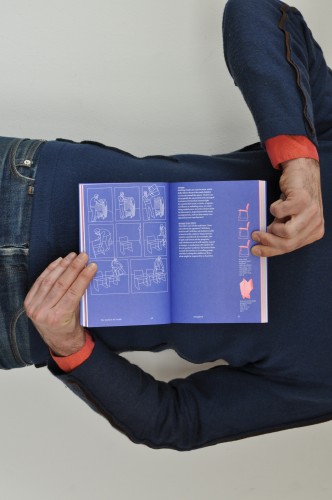
The Studio-X NY Guide to Liberating New Forms of Conversation
MTWTF, New York, New York, New York, 2010
Description
Project brief: Design a book for Studio-X New York, a Lower Manhattan satellite of Columbia University’s Graduate School of Architecture, Preservation and Planning (GSAPP), for research and events. The book should document the first two years of programming activity and highlight the dynamic, energetic and multidisciplinary nature of the programming, which spans from straight-up architecture and urbanism to performance, exhibitions and conversations on the interrelationship of cities and food, politics, policy and the humanities. Instead of feeling like a catalog of past events, the book should uncover and foreground the transferable lessons discerned through operating the space. In form and content, it should serve as a manual or how-to guide for creating conversation about cities for anyone, anywhere (including at other Studio-Xs in Beijing, Amman, Rio and Mumbai). It should be universal, legible, accessible and transferable, while being grounded in the archive and event history specific to Studio-X New York.
Approach: We created a two-part narrative of the space: theory and practice. The first half of the book is the “theory” for creating conversation as based on the history and use of Studio-X New York and its specific location on the 16th floor of 180 Varick Street. This includes its frequent and speedy transformation from an office space to an event space, its flexibility as a physical, mental, social and creative space, and the menu of programming available. We called these distinct categories of programming “event typologies,” and gave each typology an icon.
The second half of the book is the “practice,” or evidence of how the theory played out over the first two years of Studio-X New York’s public programming. The entries in this section (titled “Activate”) are arranged in chronological order and include ephemera, interviews, original essays, drawings, diagrams, excerpted transcripts and traces of activities at Studio-X alongside reinterpretations of past events by those who created them. The icon system defined in the theory section of the book carries over into this section, classifying each entry in singular or multiple ways while visually and conceptually linking the theory and practice of Studio-X New York–specific conversation into one cohesive “manual.”
Since many of the images were taken for documentation purposes only, we used a limited color palette to create a unified look and feel for the book. We chose the trim size and materials for the cover to give the object a feeling of a travel guide or something that would feel durable enough to be taken “into the field” and used in an active manner.
Effectiveness: We imagine that the hybrid nature of the book—part theory, part practice—can serve as a model for future books in any field of inquiry.
From the client: “The book has been widely used by the Columbia University GSAPP Development Office as a promotional piece to gather interest and funding for the launch of Studio-X’s Global Network, including the recent opening of Studio-X Mumbai in February 2011. The book is sold at each Studio-X space and is utilized as a model for public programming at these spaces.
“While the book was officially published in 2010, it was recently released from Distributed Art Publishers and is now available in bookstores. While it is too early to offer a sales figure for these particular bookstore copies, the book has been selling strongly online and at events at Studio-X and elsewhere.
“In October 2010, the book launched to a crowd of over 200 people at Storefront for Art and Architecture. As a continuation of the book’s themes, the launch took the form of a Book Launch Cabaret, a new event typology, in which contributors presented performances that captured how Studio-X New York liberated conversation for them.
“Future media coverage is planned for Domus and Places: Design Observer. The book was named one of the Top Ten Architecture and Design Books of 2010 by Architizer.”
Juror Notes
Information-rich process story. Extremely effective. Two-color with a lot of impact, appropriate size.
Credits
- Design firm
- MTWTF, New York
- Designers
- Juan Astasio, Glen Cummings, Aliza Dzik
- Design
- Clara Emo-Dambry
- Designers
- Lanny Hoang, Hyung Jin Kim
- Editor
- Gavin Browning
- Client
- GSAPP Books













